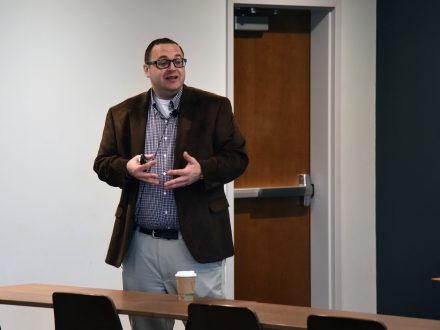Adam Lalor, a well-renowned scholar on neurodiversity and vice president of neurodiversity research and innovation at Landmark College, spoke with Elon faculty and staff on Wednesday, Oct. 25.
The Center for the Advancement of Teaching and Learning (CATL) at Elon University this fall hosted an all-day seminar on exploring neurodiversity and learning.
Adam Lalor, a well-renowned scholar on neurodiversity and vice president of neurodiversity research and innovation at Landmark College, spoke with Elon faculty and staff on what neurodiversity is, what it isn’t and what it means for student learning. Lalor offered three sessions during his visit to Elon — “Untangling Neurodiversity and Neurodivergence,” “Inclusive Assessment,” and “Neuro-Diversifying Conceptions of Diversity.”
Lalor, who identifies as disabled and neurodivergent with two neurodivergent children and a neurodivergent spouse, said a good place to start is recognizing whether to use “people-first” language or “identity-first” language.
People-first language has the person come before the descriptor, and identity-first has the descriptor before the person. While Lalor is comfortable with both, it’s important to find out what others prefer.
“Generally, what we need to know as faculty and staff on campus are the manifestations. What are the different things that students are struggling with rather than what their label is,” Lalor said.
“But when we are going to use things like language about the disability, it’s really important to have some type of reason behind it.”
Often the term “neurodiversity” is equated to “neurodivergent,” which is not the case, Lalor said. Neurodiversity refers to everyone as all brains are different from one another. Neurodivergent refers to persons who have brains that differ significantly from what society has considered the “norm.” Neurotypical refers to persons whose brains align with society’s perception of the “norm.”

“Everyone is a part of the fabric of neurodiversity,” Lalor said. “The interesting thing is the norm changes significantly.”
When it comes to the topic of neurodiversity, the default reaction is to think that someone is “weird.” Lalor insisted that the correct way to frame this idea is that people are “wired” differently, as the letters between “w” and “d” rearranged on his PowerPoint presentation.
Lalor mentioned a quote from Harvey Blume — “Neurodiversity may be every bit as crucial for the human race as biodiversity is for life in general. Who can say what form of wiring will prove best at any given moment” — that punctuated his point that society needs people to “work at the margins” and create the paradigm shifts needed to change our society.
When provided with equitable opportunity and considered in the design of a program, Lalor said that neurodivergent students can learn and be successful in higher education. Higher education was created for the elite and while there have been efforts to correct that, there has not been a concerted effort to serve neurodivergent students.
There need to be neurodivergent allies to work with and on behalf of neurodivergent students, Lalor said, and with that true change can be seen.
“The biggest thing I hope I can leave you with is … try to see individuals as individuals,” Lalor said, “because it will get you very far with this population and really any diverse population that you might interact with.”



